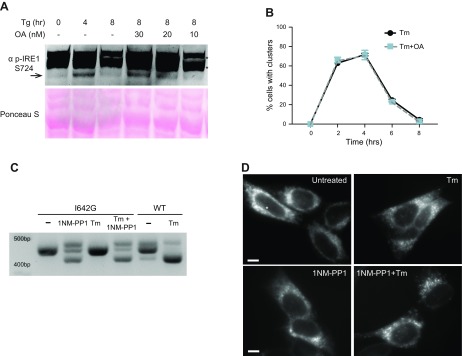Figure 7.
Effects of persistent phosphorylation and nucleotide binding on clustering. A) Okadaic acid treatment prolongs phosphorylation of IRE1α. HAP1 cells were treated with Tg (0.2 μM) and okadaic acid (OA) (30, 20, or 10 nM) for the indicated times. Cells were lysed and subjected to Western blot analysis with anti-phospho-serine 724 in the activation loop of IRE1α. Arrow, specific phosphoS724 species; asterisk, nonspecific bands. B) Sustained phosphorylation of IRE1α does not affect the kinetics of clustering. HAP1KO cells expressing WT IRE1GFP were treated with 4 μg/ml Tm alone or Tm+ 30 nM OA. Cells were imaged at the indicated times and the percentage of cells with clusters was graphed. C) The XBP1 splicing activity of HAP1KO cells expressing I642G IRE1GFP is induced by treatment with 1NM-PP1 but not Tm. HAP1KO cells expressing I642G IREGFP were treated with 1NM-PP1 (4 μM) for 4 h. RT-PCR was performed as before. D) Intracellular distribution of I642G IREGFP in HAP1KO with and without the ATP mimetic ligand 1NM-PP1 and with and without Tm. HAP1KO cells expressing I642G IREGFP were treated with 1NM-PP1 (4 μM) and Tm (4 μg/ml) for 4 h and imaged as previously. Scale bars, 10 μm.

